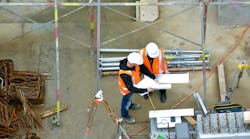Every company cares about safety and health in the workplace — no one wants anyone to become ill or get hurt. That’s why companies invest so much time, effort, and money in trying to create safe working environments. Although they would inevitably do this without government regulation, managing compliance with federal and state OSHA requirements is an indispensable part of safety in this day and age. For electrical contractors — as well as other subcontractors — on a job site, it’s important to know what to expect when and if OSHA comes calling.
In an investigation, there is not only a review of onsite conditions and records, but also a concentrated effort to unearth information from the past as well as the present. This is done partially through observation and casual questioning regarding conditions, but, more importantly, it is done through in-depth examination of documents and utilization of private one-on-one witness interviews, including both hourly and supervisory personnel.
The OSHA compliance officer is a professional investigator; the contractor is not. Contractors must be aware of and prepared to respond to the questions that may be asked in interviews. Will the questions be properly phrased to elicit truth, or will they be confusing to the witness? Can the witness have assistance from the contractor? What if OSHA demands documents that you do not believe you should have to turn over? Can OSHA hold a contractor responsible for past events? Can OSHA increase enforcement because of conditions a contractor had notice of previously?
This article provides contractors with an overview of the OSHA inspection process as well as tips for compliance if OSHA happens to come knocking at your door. In addition, it includes a summary discussion of OSHA citations, giving contractors a better understanding of what citations are as well as what to do if they are issued a citation.
What to do when OSHA is on the job site
When an OSHA compliance officer shows up at your job site, it is almost always an enforcement event — not just an inspection related to specific conditions or an audit of records. It is rarely, if ever, a random inspection. In this situation, prudent contractors should be prepared in advance because OSHA has shifted to an enforcement strategy involving inspections and citations rather than a compliance strategy involving education and prevention.
It is in every contractor’s best interest not only to be safe, but also to have a good safety compliance record. It is important to safeguard the company’s interest in all types of OSHA events. Many companies receive regular OSHA inspections, while others never get inspected. All companies have continuing affirmative obligations, and all are potentially subject to investigation by OSHA at any time. It is also in every company’s interest that it not be subjected to unfair investigative techniques and that OSHA’s factual findings are not based on inappropriate speculation.
Inspections and investigations by OSHA are initiated for any number of reasons. If a compliance officer is on your job site, first you need to know why. The answer can significantly affect how you respond. If there has been a fatal accident, of course, you know why an investigation is being initiated.
A fatal accident is the worst thing that can happen at the job site. One minute everything is fine, and no one can imagine that something terrible is about to happen. The next minute, everyone on the property is in shock. The unimaginable has happened. Not only is the event emotionally devastating, but it also throws the company immediately into a legal morass.
Company officials need to be prepared to respond to serious situations that they hope will never happen. They need to be prepared and then hope that their preparations are merely “insurance” — that these plans will never have to be implemented. Accidents and all other circumstances that prompt OSHA investigations must be planned well in advance so that the company will know what to do immediately when dealing with the unexpected. Preparation is key.
No OSHA inspection is routine
Agency investigations and audits can give rise to very serious legal consequences. Civil penalties can be extremely costly. Even criminal prosecutions are a possibility in extreme circumstances — and you never know what is extreme until the facts are uncovered during the investigation. Accidents can give rise to civil liability, and can raise potentially complicated workers’ compensation and insurance issues as well as lead to regulatory liability. All inspections conducted by OSHA can have an impact on workforce morale, and can result in major sanctions against the company.
To help contractors through an OSHA investigation, they should review the following tips (highlighted in this Photo Gallery), all of which are important (but not exhaustive) elements of an OSHA inspection response plan.
What an OSHA citation really means
A citation is actually just an allegation — it is not a legally final document. Roughly speaking, it is the administrative equivalent of a complaint filed in court, which means it contains allegations, not conclusive findings. There are many parts of the form citation language and the contents of the citation items themselves that may sound like conclusory findings. OSHA even conveniently provides you an invoice and notice of debt collection. The packet looks and sounds final. It is, but only from OSHA’s perspective — and the government is not always right!
The citation becomes final only after you agree with the citation or some modification thereof (possibly through settlement discussions), fail to contest the citation, or contest the citation and lose in the administrative litigation process that follows. The key distinction with a typical lawsuit is that OSHA has at least conducted some form of investigation — by law, it has to — and it has an investigation file that should (though not necessarily) contain evidence on which it based the items in the citation. As many contractors may have experienced, it takes little for someone to sue in court, and there is little evidence (if any, frankly) that courts require before allowing a complaint (mere allegations) to proceed.
With this in mind, you should not automatically accept the citation as-is. Look at it as a statement of OSHA’s position. Also assume there is at least some evidence in the government’s investigation file that supports OSHA’s position. You won’t get to see the investigation file unless you contest the citation and proceed to the administrative litigation process, but you can get a better understanding of what it contains if you schedule an informal conference with the area director before your contest period expires. Always elect to have an informal conference because you will learn something new and can ask questions about the evidentiary basis for the citation.
When analyzing a citation, the key determination is whether you discovered any evidence during your own investigation that supports OSHA’s position. If there are any repeat, willful, or serious violations — and your own investigation shows no evidence supporting such violations — then you have little choice here. You must convince OSHA to re-classify or timely file your notice of contest. A repeat violation is one where, upon re-inspection, OSHA finds a substantially similar violation typically within the last three years. A violation is willful if you knew of a condition that violated a standard, and you committed it voluntarily or with intentional disregard or plain indifference to the law. A serious violation presents a substantial probability that death or serious physical harm would result. The issue is not whether there is a substantial probability that an accident will occur, but rather if an accident occurs, is there a substantial probability that death or serious harm will result.
Many contracting agencies will not let you bid for work if you have a poor safety record, so repeat, willful, or too many serious violations can become “bet the company” problems. Protecting your business is why it is critical that during the investigation (i.e., before you get a citation), you hire experienced outside legal counsel to direct your investigation if you have a fatality, catastrophic injury, or other investigation in which a repeat, willful, or numerous serious violations are even remotely possible. Your best chance at getting through an OSHA investigation is with the guidance of a qualified and experienced attorney who will almost always be more thorough than OSHA and will have the advantage of conducting an investigation protected by attorney/client-privileged communications and confidential attorney work product that the government cannot access. There are many outstanding safety consultants in the electrical construction industry, but unless they are directed by an attorney, their work product and communications are not protected and must be disclosed at some point if you contest a citation.
On a procedural note — you should act immediately. When you receive the citation, you have 15 working days to respond. You cannot get an extension of any amount of time. If you disagree with any aspect of the citation, you must either resolve the issue with OSHA or file a notice of contest before the 15-day period runs. If you fail to do so, you have forever lost your chance, and the citation becomes final. Excuses such as an internal mail routing mistake will not work. We sometimes receive advanced notice from OSHA through a closing conference, but not always. We also recommend calendaring the 15-day contest period starting with the issuance date shown at the top of the citation’s first page, rather than the date you received the citation. This gives you a cushion that may be very helpful. Note that the date is calculated using working days — this means you exclude weekends and federal holidays in your calculation.
Responding to OSHA citations is not just about protecting your business; it is about protecting your people and showing the government you did all you could do to prevent an accident from happening. If you plan to contest a citation, it is critical to show you have:
• A written, comprehensive, but readable safety program that has detailed guidance on the most common hazards your employees will encounter (e.g., fall protection and trenching);
• A recurring classroom and field training program that ensures employees have the skills and education they need to avoid or abate any hazards; and
• An enforcement record showing you discipline employees when they violate any safety rules or engage in any conduct that puts others at risk and supervisors that fail to enforce your safety rules. In our experience, an enforcement record is the most critical component — it shows you take your safety program seriously.
If you have not done so recently, audit your workplace safety program. Just think, would you be ready to show these things if tragedy strikes?
Russell is an OSHA lawyer who represents contractors in all matters relating to workplace safety and compliance, among other labor and employment law issues. He is a shareholder in the Tampa office of the international labor and employment law firm of Ogletree Deakins. He can be reached via email at [email protected], on LinkedIn at philrusselllaw, and on Twitter at philrussell_law.



